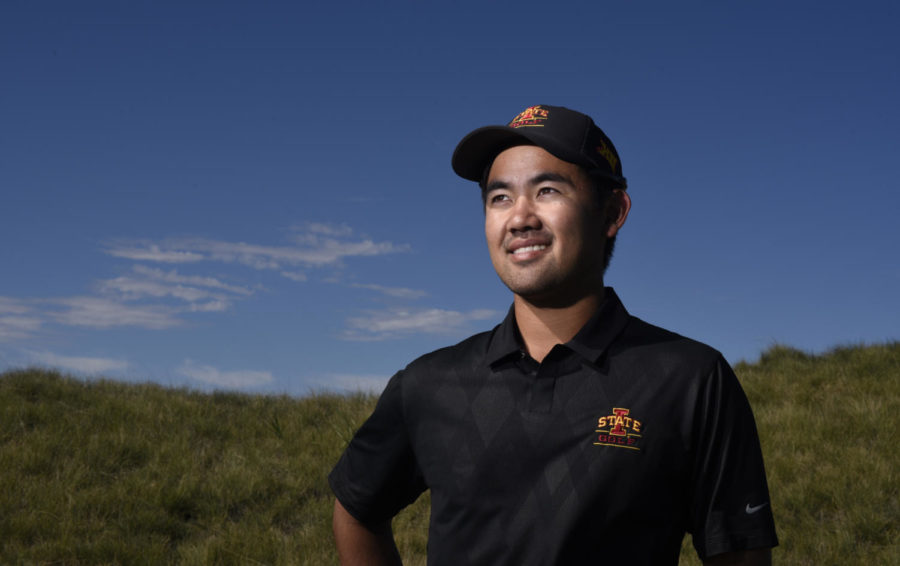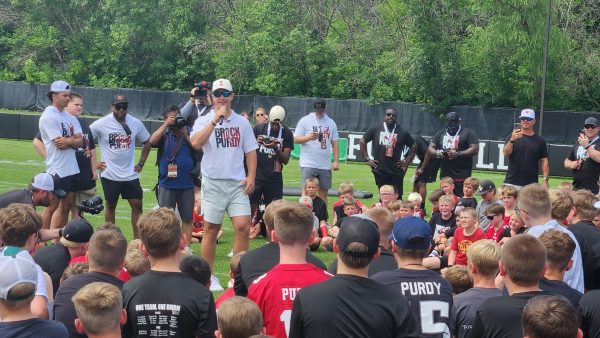ISU men’s golf team reflects on importance of the junior golf ranks
Ruben Sondjaja, junior in management, poses for a portrait Wednesday, Sept. 30 at the ISU Golf Performance Center in Ames, Iowa. Sondjaja will be Iowa State’s No. 1 starter at the Bridgestone Golf Collegiate on Oct. 25-26 due to the absence of Nick Voke, who is representing New Zealand at the Nomura Cup.
October 1, 2015
In today’s era of professional golf, a youth movement has proliferated the PGA Tour, with the likes of Jordan Spieth and Rory McIlroy grabbing major championships while still in their early 20s.
Sure, Tiger Woods was doing the same at a similar age in the 1990s, but Woods was more of a boy among men compared to the dozens of players in their 20s finding success on the PGA Tour today.
Six of the last eight major championships have been won by players in their 20s, and 11 of 30 players who competed in last week’s Tour Championship had yet to reach their 30th birthday.
Players’ readiness to compete on the highest levels at earlier ages can be heavily attributed to the strength of competition in the junior ranks.
“Growing up, junior golf was massive for me,” said ISU men’s golfer and Australian Ruben Sondjaja, who has professional aspirations of his own. “I played in lots of big junior tournaments. It’s kind of amazing to see how junior golf has developed and progressed over the last few years.”
For many golfers looking to get their name out to prospective colleges, the junior golf circuit has become the best way to do so as opposed to traditional high school matches.
The American Junior Golf Association and other junior tours have advanced from hosting a handful of tournaments nationwide in a month to several per week for players of nearly all ages around the United States and internationally.
“If I just played high school and didn’t play in junior events, I wouldn’t be here,” said ISU golfer Jack Carter. “I’d probably be playing at a smaller school back home that was close. Just getting the exposure of getting across state lines and playing in big tournaments where a lot of good players are going to be is good for recruiting.”
Several junior golf rankings exist in calculating the next top prospects. Worldwide and national competition, not unlike what professional golfers experience, has become common, if not expected.
For golfers like Sondjaja, traveling around the United States as a Cyclone is old hat for someone who has been cutting his teeth on the international circuit since he was 8 years old.
“I did a lot of traveling and learned to travel to places by myself,” Sondjaja said. “Just the knowledge of traveling and what that involves. On my way here, I was already exposed to the things I’d face. Before I came to Iowa State, I was in Europe touring for a month over there.”
The importance of competing outside of your backyard is understood universally in the golf world, but a separation exists in terms of international versus American golfers who come to ISU golf coach Andrew Tank’s program.
“I think the international players have maybe come from a little bit more of an environment of a team aspect of things, whether they play for their club team, their state team [or] their national team,” Tank said.
High school teams like those in the United States are virtually nonexistent abroad, but a more holistic approach to junior golf is more common. International junior golfers, particularly in golf-oriented nations like Spain, Australia and New Zealand, are more prone to specialization, in which the mental and physical training are joined with golf-specific instruction.
Spanish golfers like current ISU golfer Jorge Utrilla and recently-graduated Scott Fernandez come from competing heavily with the Spanish national team, and Sondjaja has captained his junior state team, New South Wales.
Tank said more American golfers are starting to receive similar holistic training, and that as a whole, golfers are more polished and ready to compete at the Division I level from the get-go.
“I think if you look nationally there’s a lot of freshmen [competing],” Tank said. “These top juniors are stepping right into college golf and competing at the highest levels. I think that’s definitely a result of more competition at a younger age.”

















